So, about these injector seals...
Posted: Wed May 10, 2017 7:43 pm
So, first of all I must apologise for my ignorance of the N/A engines 
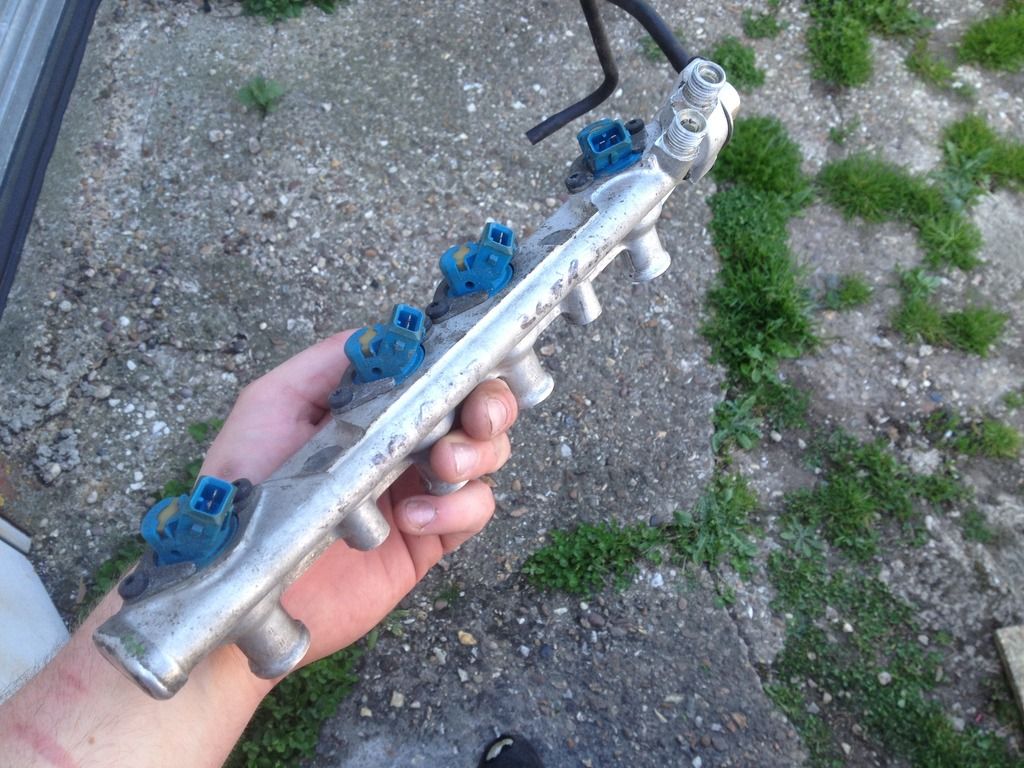
Don't ask me why I have this but here is a fuel rail and injectors for a B20F. My assumption that the injector layout would be the same on the N/A engines was wrong, at least in the case of the 2.0 engine.
Anyhow, after a quick bit of google image searching with terms like 'B18F injectors', I think the layout on the 1.7 is more similar to the turbo and the seals should be the same (I hope!)
These 2.0 ones have what looks like the same standard 14mm seal at the bottom but a larger one around the middle, the fuel is not fed in from the top of the injector and it looks like this assembly probably attaches to the manifold rather than the injectors sitting directly in bores in the head. There must be extra seals at the mating faces between fuel rail and manifold/head so I guess these may be an additional source of problems on the B20F but anyway back to the turbo and hopefully the 1.7-
I didn't actually get a chance to take the rail out of my spare engine but I did get a couple of photos and along with other pics I have of my engine in bits I think I can manage
First of all you will need to remove the top part of the inlet manifold to gain access to the injectors, obviously the procedure for this will vary from engine to engine but shouldn't be too taxing. Throttle cable will have to be disconnected and all pipework, brackets etc from the manifold and throttle body (or detach the throttle body complete and leave in situ while just removing the manifold itself).
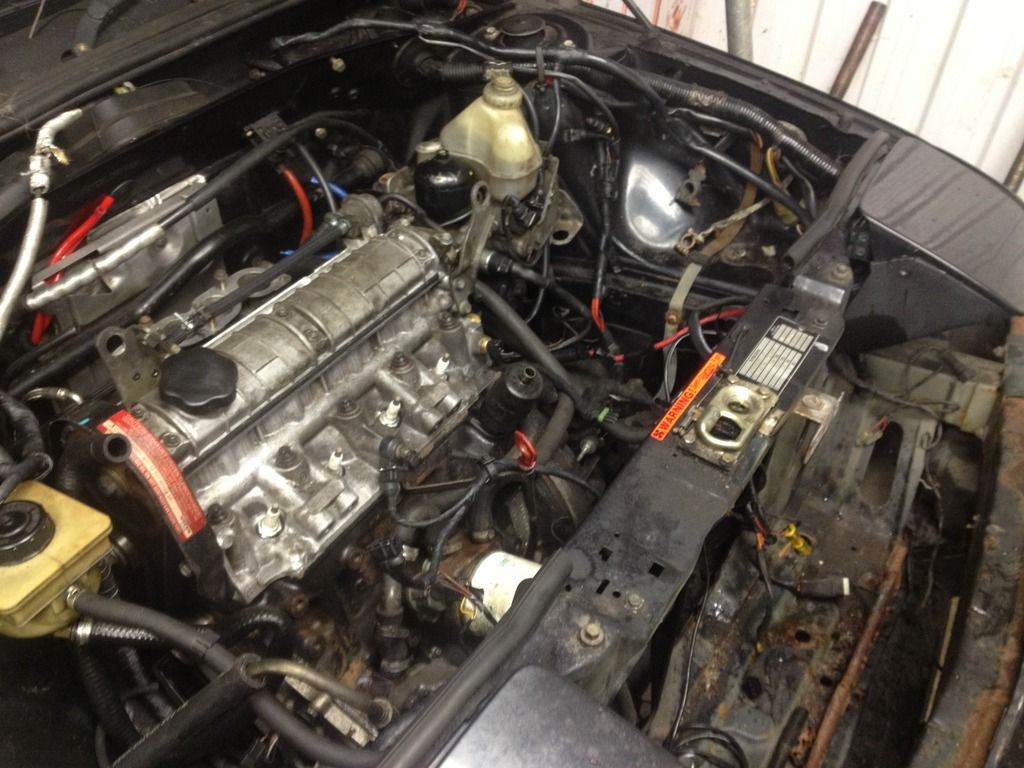
Here's a picture in which you can see the engine with top manifold removed, plus lots of other stuff! Don't worry, you don't need to go this far, this was a picture from the build of my black one Just so you can see where the joint flange is where the two halves of the inlet manifold meet. If you don't have replacement gaskets handy then just apply a little bead of RTV on the faces prior to reassembly, cleaning them first obviously. Ultimately, new gaskets is best but RTV works just fine.
Just so you can see where the joint flange is where the two halves of the inlet manifold meet. If you don't have replacement gaskets handy then just apply a little bead of RTV on the faces prior to reassembly, cleaning them first obviously. Ultimately, new gaskets is best but RTV works just fine.
Another old picture but illustrative for the purposes of this-
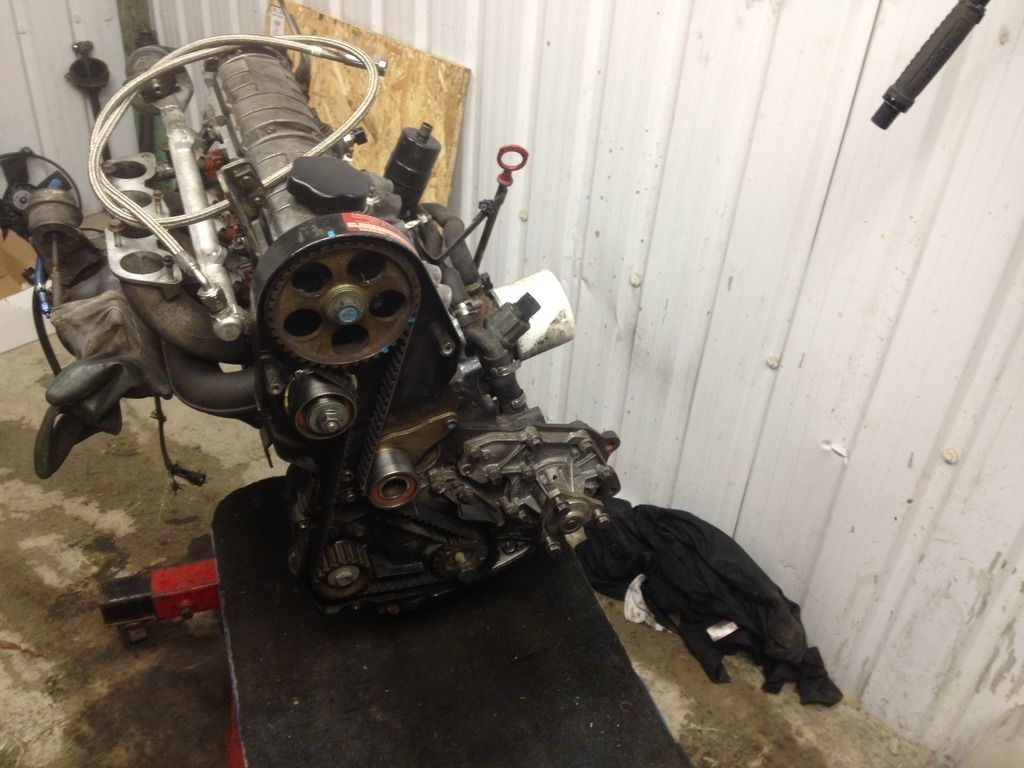
Here you can clearly see the fuel rail above the injectors. In this case the injectors have a 14mm seal at both ends which fit into respective bores on the rail and in the head. The rail is held in place with a bolt into a bracket at either end. I'm hoping this is similar to the 1.7 as the 2.0 is obviously different, anyone with a B20F, feel free to shed more light on this and pics of B18F's and E's and EP's and whatever else wouldn't go amiss either..... I'm curious now!
I'm curious now!
Here's one of the brackets-
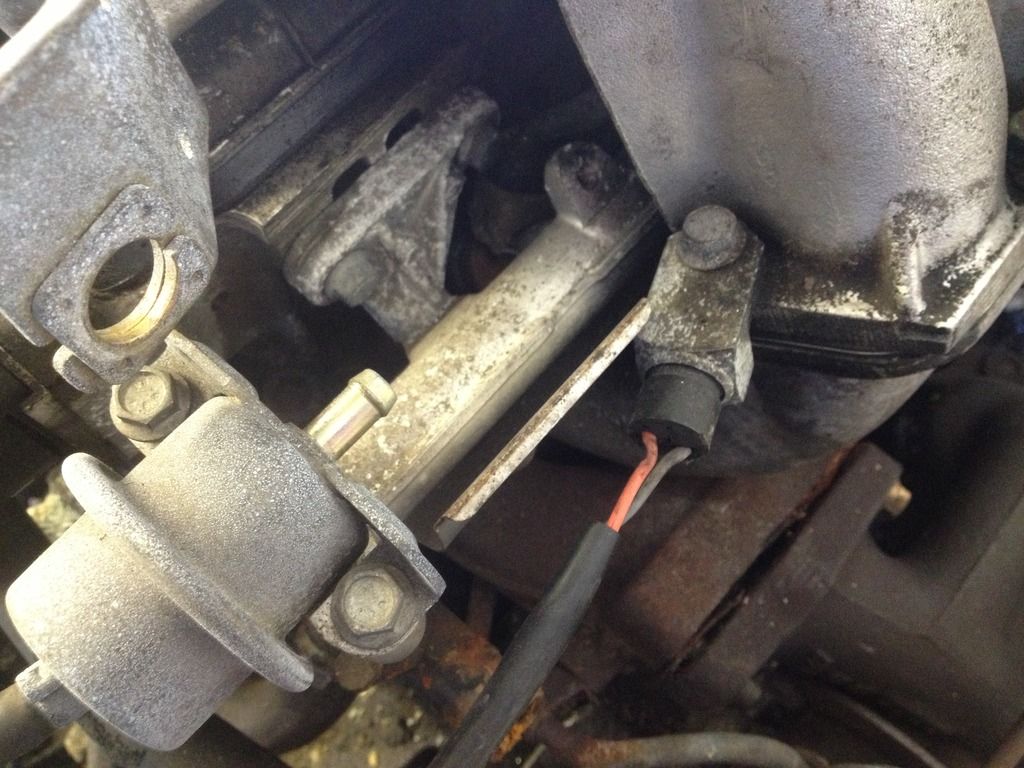
The other end you can't see because of the wiring connector-
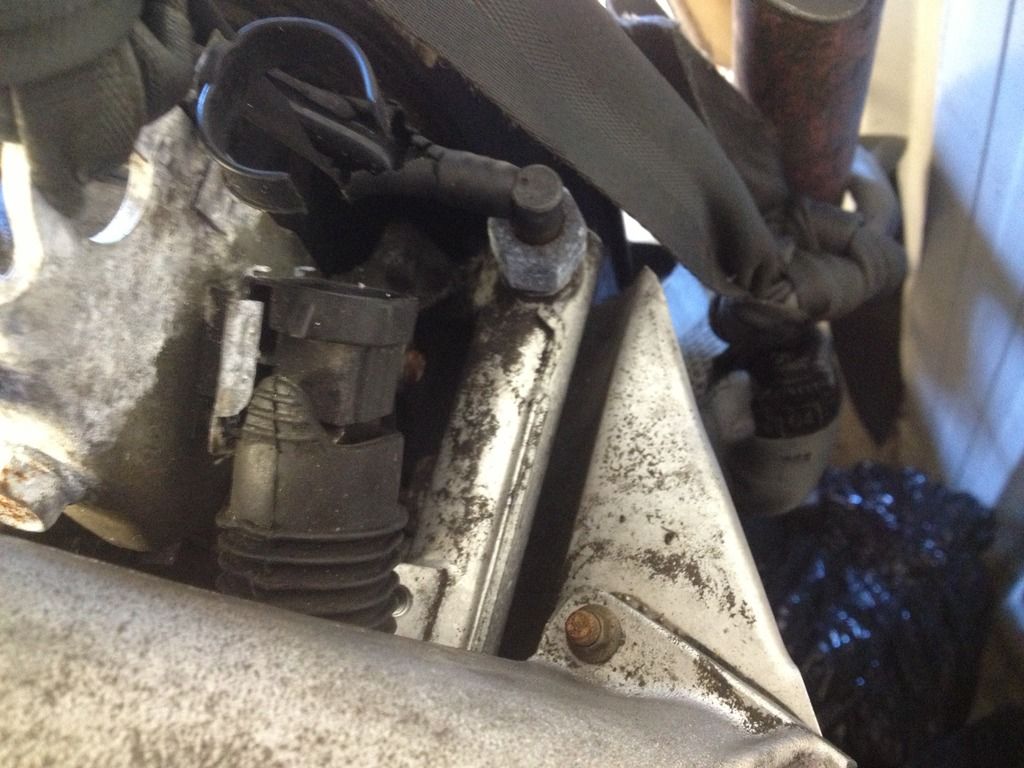
It is there, promise
Once the securing bolts are removed the rail, complete with injectors should pull off, all that is holding it in is the fit of the seals in the bores in the head. Before removing the rail you will of course need to remove the fuel line and the connector from the injector harness (which can be left in situ and taken out as a complete assembly, the plugs on the injectors are easier to get off once the rail is out, you will just have to release the main connector block from the bracket where it's attached). In an ideal world you will depressurise the fuel system by some means or other before cracking the fitting off. If they've never been out before, they may need quite a lot of wiggling and encouragement! The injectors are retained in the rail with clips, these top seals will most likely be fine, it's the ones in the head that suffer because of the heat, the flowing fuel helps to cool the top ones more and they are more isolated from combustion heat.
new seals will look like this-

The blue viton rubber is good for around +10 bhp
(martin- these are now in an envelope and will be winging their way to you shortly, I just hope your engine has the same layout and injector bore size as the turbo and not the 2.0 as these may not do the trick, although they should fit the lower part of the injector there are apparently more seals lurking that I'm unaware of looking at that B20F rail assembly!)
The old seals can easily be prised from the injector body with a small screwdriver or pick, or they might just break away, they can get very brittle with age, the new ones should be fitted with care. If possible, clean out the bores in the head and apply a small amount of lubricant to help the seals slide in, they are a tight fit and there is potential for damaging them during installation, try to get all four to slip in nicely together.
These are an often overlooked item and if you've got running problems either constantly or under certain temperature conditions and you seem to have come to a brick wall and you don't know where to turn next, having changed loads of stuff and still not cured it and you can't find any obvious air leaks, then this is a good shout.
Martin- I'm not promising a miracle cure here for your hot starting issue, it could well be something else as yet undiscovered but this seems like a sensible (and worthwhile anyway) next step. Mine, although it wouldn't refuse to start when hot, did run really appallingly and would stall often without throttle after a bit of a heat soak and as I said to you, the only thing I changed in the course of the head rebuild that stands a chance of being the reason behind why it no longer does this is, you guessed it, injector seals All major ignition and fuel system components were unchanged from one car to the other, it was installed with all the same gear, right down to the loom and ECU's as you know. I suppose the only other potential for air leakage that was changed was the manifold gasket but I'd say the bottom injector seals are much more vulnerable to age and mileage. It does smack of classic vapour lock but that just should't happen with a system like this. Is the Renix system the same as the Bosch in that the fuel pump is not activated until there's a speed signal or does the pump prime when you turn the ignition on?
All major ignition and fuel system components were unchanged from one car to the other, it was installed with all the same gear, right down to the loom and ECU's as you know. I suppose the only other potential for air leakage that was changed was the manifold gasket but I'd say the bottom injector seals are much more vulnerable to age and mileage. It does smack of classic vapour lock but that just should't happen with a system like this. Is the Renix system the same as the Bosch in that the fuel pump is not activated until there's a speed signal or does the pump prime when you turn the ignition on?
If it does, it would be interesting to prime the fuel system a few times on the key and then try it. Any vapour lock should be purged by doing this as the fuel flows to the rail and back to the tank via the return, like bleeding the system.
If not, you could still try 'priming' the system by manually activating the fuel pump with a jumper in place of the relay, then try starting it, either leaving the jumper in to run the pump or refitting the relay, whichever, just don't forget to take the jumper out again
If it starts when 'primed' then it could well be a vapour lock forming somehow and would need more investigation.
People- feel free to add pictures, comments and additional/corrected information about anything injector or fuel rail related here

Don't ask me why I have this but here is a fuel rail and injectors for a B20F. My assumption that the injector layout would be the same on the N/A engines was wrong, at least in the case of the 2.0 engine.
Anyhow, after a quick bit of google image searching with terms like 'B18F injectors', I think the layout on the 1.7 is more similar to the turbo and the seals should be the same (I hope!)
These 2.0 ones have what looks like the same standard 14mm seal at the bottom but a larger one around the middle, the fuel is not fed in from the top of the injector and it looks like this assembly probably attaches to the manifold rather than the injectors sitting directly in bores in the head. There must be extra seals at the mating faces between fuel rail and manifold/head so I guess these may be an additional source of problems on the B20F but anyway back to the turbo and hopefully the 1.7-
I didn't actually get a chance to take the rail out of my spare engine but I did get a couple of photos and along with other pics I have of my engine in bits I think I can manage
First of all you will need to remove the top part of the inlet manifold to gain access to the injectors, obviously the procedure for this will vary from engine to engine but shouldn't be too taxing. Throttle cable will have to be disconnected and all pipework, brackets etc from the manifold and throttle body (or detach the throttle body complete and leave in situ while just removing the manifold itself).

Here's a picture in which you can see the engine with top manifold removed, plus lots of other stuff! Don't worry, you don't need to go this far, this was a picture from the build of my black one
Another old picture but illustrative for the purposes of this-

Here you can clearly see the fuel rail above the injectors. In this case the injectors have a 14mm seal at both ends which fit into respective bores on the rail and in the head. The rail is held in place with a bolt into a bracket at either end. I'm hoping this is similar to the 1.7 as the 2.0 is obviously different, anyone with a B20F, feel free to shed more light on this and pics of B18F's and E's and EP's and whatever else wouldn't go amiss either.....
Here's one of the brackets-

The other end you can't see because of the wiring connector-

It is there, promise
Once the securing bolts are removed the rail, complete with injectors should pull off, all that is holding it in is the fit of the seals in the bores in the head. Before removing the rail you will of course need to remove the fuel line and the connector from the injector harness (which can be left in situ and taken out as a complete assembly, the plugs on the injectors are easier to get off once the rail is out, you will just have to release the main connector block from the bracket where it's attached). In an ideal world you will depressurise the fuel system by some means or other before cracking the fitting off. If they've never been out before, they may need quite a lot of wiggling and encouragement! The injectors are retained in the rail with clips, these top seals will most likely be fine, it's the ones in the head that suffer because of the heat, the flowing fuel helps to cool the top ones more and they are more isolated from combustion heat.
new seals will look like this-

The blue viton rubber is good for around +10 bhp
(martin- these are now in an envelope and will be winging their way to you shortly, I just hope your engine has the same layout and injector bore size as the turbo and not the 2.0 as these may not do the trick, although they should fit the lower part of the injector there are apparently more seals lurking that I'm unaware of looking at that B20F rail assembly!)
The old seals can easily be prised from the injector body with a small screwdriver or pick, or they might just break away, they can get very brittle with age, the new ones should be fitted with care. If possible, clean out the bores in the head and apply a small amount of lubricant to help the seals slide in, they are a tight fit and there is potential for damaging them during installation, try to get all four to slip in nicely together.
These are an often overlooked item and if you've got running problems either constantly or under certain temperature conditions and you seem to have come to a brick wall and you don't know where to turn next, having changed loads of stuff and still not cured it and you can't find any obvious air leaks, then this is a good shout.
Martin- I'm not promising a miracle cure here for your hot starting issue, it could well be something else as yet undiscovered but this seems like a sensible (and worthwhile anyway) next step. Mine, although it wouldn't refuse to start when hot, did run really appallingly and would stall often without throttle after a bit of a heat soak and as I said to you, the only thing I changed in the course of the head rebuild that stands a chance of being the reason behind why it no longer does this is, you guessed it, injector seals
If it does, it would be interesting to prime the fuel system a few times on the key and then try it. Any vapour lock should be purged by doing this as the fuel flows to the rail and back to the tank via the return, like bleeding the system.
If not, you could still try 'priming' the system by manually activating the fuel pump with a jumper in place of the relay, then try starting it, either leaving the jumper in to run the pump or refitting the relay, whichever, just don't forget to take the jumper out again
If it starts when 'primed' then it could well be a vapour lock forming somehow and would need more investigation.
People- feel free to add pictures, comments and additional/corrected information about anything injector or fuel rail related here